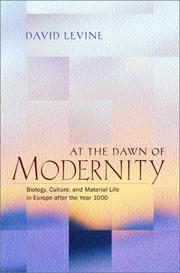| Listing 1 - 3 of 3 |
Sort by
|

ISBN: 0521801508 0511325460 0511047592 9786610430390 0511542526 0511156510 1280430397 0511175833 1107122686 0511015992 9780511015991 9780511175831 9780511542527 9780511047596 9780511156519 9781280430398 9780521801508 9780521017763 0521017769 9781107122680 9780511325465 661043039X Year: 2001 Publisher: Cambridge Cambridge University Press
Abstract | Keywords | Export | Availability | Bookmark
 Loading...
Loading...Choose an application
- Reference Manager
- EndNote
- RefWorks (Direct export to RefWorks)
The threat of unstoppable plagues, such as AIDS and Ebola, is always with us. In Europe, the most devastating plagues were those from the Black Death pandemic in the 1300s to the Great Plague of London in 1665. For the last 100 years, it has been accepted that Yersinia pestis, the infective agent of bubonic plague, was responsible for these epidemics. This book combines modern concepts of epidemiology and molecular biology with computer-modelling. Applying these to the analysis of historical epidemics, the authors show that they were not, in fact, outbreaks of bubonic plague. Biology of Plagues offers a completely new interdisciplinary interpretation of the plagues of Europe and establishes them within a geographical, historical and demographic framework. This fascinating detective work will be of interest to readers in the social and biological sciences, and lessons learnt will underline the implications of historical plagues for modern-day epidemiology.
Black Death --- Epidemics --- Epidemics. --- Plague. --- History --- Black Death. --- Epidemics - Europe - History - 17th century. --- Plague --- Public Health --- Yersinia Infections --- History, Modern 1601 --- -History, Early Modern 1451-1600 --- Environment and Public Health --- Enterobacteriaceae Infections --- Humanities --- Gram-Negative Bacterial Infections --- Health Care --- Bacterial Infections --- Bacterial Infections and Mycoses --- Diseases --- History, 16th Century --- History, 17th Century --- Disease Outbreaks --- Health & Biological Sciences --- Epidemiology & Epidemics --- Bubonic plague --- Disease outbreaks --- Outbreaks of disease --- Pestilences --- Outbreaks --- Yersinia infections --- Medicine, Medieval --- Communicable diseases --- Pandemics --- Life Sciences --- General and Others

ISBN: 0415927153 Year: 2001 Publisher: New York (N.Y.) Routledge
Abstract | Keywords | Export | Availability | Bookmark
 Loading...
Loading...Choose an application
- Reference Manager
- EndNote
- RefWorks (Direct export to RefWorks)
Apocalyptic literature --- Black Death --- Disasters --- Famines --- Hundred Years' War, 1339-1453. --- History and criticism. --- History --- -Disasters --- -Famines --- -Hundred Years War, 1339-1453 --- -Epidemics --- Literature, Apocalyptic --- -942.04 --- -Geschiedenis van Engeland--(1399-1485) --- -Famine --- Hundred Years' War, 1339-1453 --- 942.04 --- 942.04 Geschiedenis van Engeland--(1399-1485) --- Geschiedenis van Engeland--(1399-1485) --- Famine --- Food supply --- Starvation --- Calamities --- Catastrophes --- Curiosities and wonders --- Accidents --- Hazardous geographic environments --- Epidemics --- Medicine, Medieval --- Plague --- History and criticism --- England --- Great Britain --- Civilization

ISBN: 1282758780 9786612758782 0520923677 1597344753 9780520923676 1417523832 9781417523832 9781282758780 9780520220584 0520220587 Year: 2001 Publisher: Berkeley University of California Press
Abstract | Keywords | Export | Availability | Bookmark
 Loading...
Loading...Choose an application
- Reference Manager
- EndNote
- RefWorks (Direct export to RefWorks)
Looking at a neglected period in the social history of modernization, David Levine investigates the centuries that followed the year 1000, when a new kind of society emerged in Europe. New commercial routines, new forms of agriculture, new methods of information technology, and increased population densities all played a role in the prolonged transition away from antiquity and toward modernity. At the Dawn of Modernity highlights both "top-down" and "bottom-up" changes that characterized the social experience of early modernization. In the former category are the Gregorian Reformation, the imposition of feudalism, and the development of centralizing state formations. Of equal importance to Levine's portrait of the emerging social order are the bottom-up demographic relations that structured everyday life, because the making of the modern world, in his view, also began in the decisions made by countless men and women regarding their families and circumstances. Levine ends his story with the cataclysm unleashed by the Black Death in 1348, which brought three centuries of growth to a grim end.
Human body --- Social history --- Civilization, Medieval. --- Body, Human --- Human beings --- Body image --- Human anatomy --- Human physiology --- Mind and body --- Civilization, Medieval --- Medieval civilization --- Middle Ages --- Civilization --- Chivalry --- Renaissance --- Social aspects --- History. --- History --- Europe --- Church history --- agriculture. --- black death. --- capitalism. --- class. --- commerce. --- commercial routines. --- early modernization. --- europe. --- european history. --- feudalism. --- gregorian reformation. --- history. --- information technology. --- material culture. --- modern world. --- modernity. --- plague. --- population density. --- poverty. --- social change. --- social history. --- social order. --- social science. --- sociology. --- urban life.
| Listing 1 - 3 of 3 |
Sort by
|

 Search
Search Feedback
Feedback About UniCat
About UniCat  Help
Help News
News